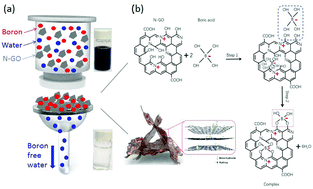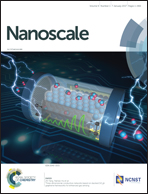Nitrogen-doped graphene oxide for effectively removing boron ions from seawater†
Abstract
Elemental boron exists in the form of boric acid or borate salts in aqueous solution. The human body is very sensitive to the amount of boron, and boron contamination in drinking water affects our health adversely. However, boron is not easily removed due to its small ionic size and is a problem to water treatment systems. Herein, we report a new method to remove boron using nitrogen-doped graphene oxide (N-GO). The maximum adsorption capacity we have obtained is 58.7 mg g−1 and this makes N-GO one of the best materials to adsorb boron. Real seawater with 5 mg L−1 as boron is used as a feed for testing and the absorption capacity is shown to be up to 2.42 mg g−1. This high adsorption capacity is mainly attributed to the large amount of hydroxyl groups distributed across the high surface area of graphene oxide and the enhanced adsorption that results from nitrogen-doped sites. Once N-GO is saturated with boron ions, it can be easily regenerated via acid treatment. Our proposed technique has high commercial value and we believe that it is very valuable to the water treatment industry.


 Please wait while we load your content...
Please wait while we load your content...